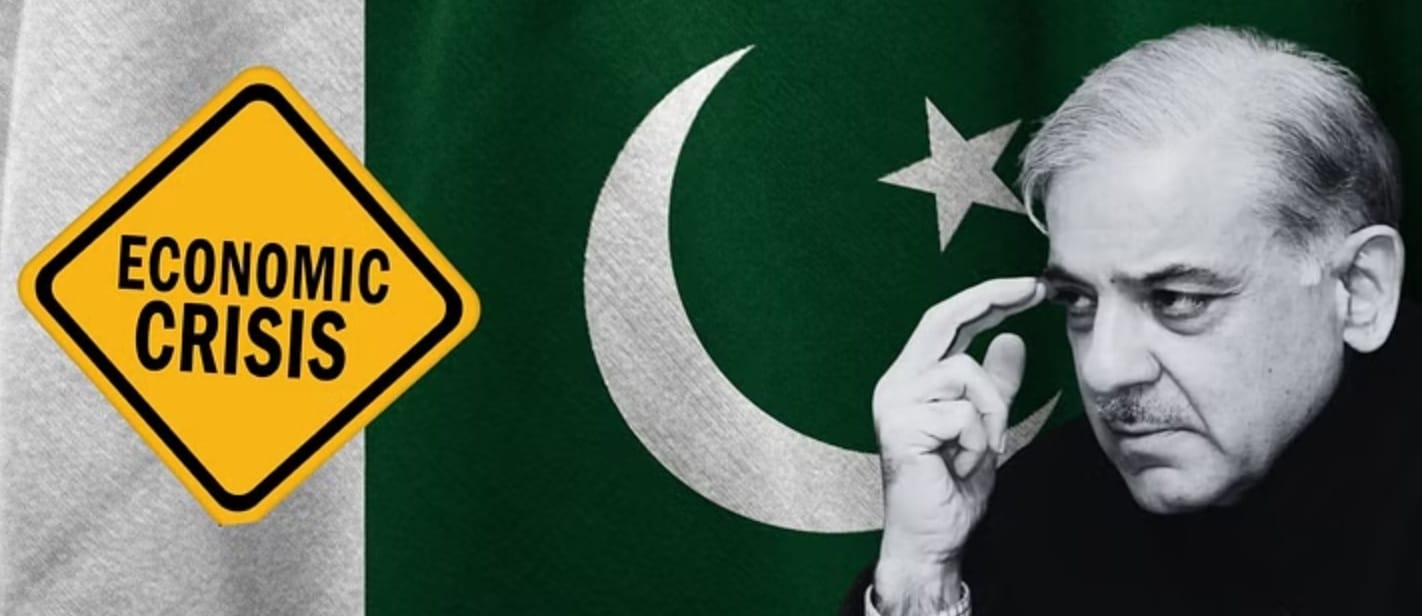What’s in today’s article?
- Why in news?
- What is the current state of Pakistani economy?
- What are the key factors behind Pakistan’s worsening economic crisis?
- What will be the impact of this Pak’s Economic crisis on India?
- News Summary: Economic Crisis in Pakistan
Why in news?
- Recently, Pakistan announced a series of measures, including closing all malls and markets by 8.30 pm, in an attempt to conserve energy amid an economic crisis.
- Also, The Pakistani administration is engaged in negotiations over the delayed release of $1.1 billion from the International Monetary Fund (IMF).
What is the current state of Pakistani economy?
- In 2022, the country’s foreign exchange reserves dwindled to a little over $9 billion, the rough equivalent of the country being able to pay for six weeks of imports.
- They hit a low of $5.56 billion in January 2023.
- Year-on-year inflation stood at 24.5% in 2022. For perishable food items, this number was 55.93%.
- The country is struggling to cope with mounting debt, inflated energy import costs, dwindling forex reserves, global inflation, political instability and a sustained drop in GDP growth.
- Such is the extent of the crisis that the government auctioned a Pakistani embassy property in the US a few days ago.
What are the key factors behind Pakistan’s worsening economic crisis?
- Pakistan’s short-sighted policy decision
- The present crisis is primarily attributed to Pakistan’s policy decision leading to extensive spending on non-developmental and economically unviable projects.
- The infrastructure projects like Gwader-Kashgar Railway line were financed through long-term debt instruments.
- Pakistan relied massively on external borrowing rather than from domestic institutions which added to its troubles.
- CPEC Projects
- Roll out of the China–Pakistan Economic Corridor (CPEC) increased the debt burden opening the doors of the ever-increasing external loans.
- Notably, CPEC created a Chinese debt of US$ 64 billion on Pakistan which was originally valued at US$47 billion during 2014.
- Persistent fall in the Pakistani Rupee against the US Dollar
- This has further contributed to the ballooning external debt.
- Role of International Institutions
- Low ranking by international rating agencies and grey listing of Pakistan in Financial Action Task Force (FATF) kept foreign investors away.
- The State Bank of Pakistan data suggests that in the past 10 years, FDI inflows into Pakistan never exceeded 1percent of GDP.
- The vicious cycle of seeking fresh loans and repaying old ones has led Pakistan into the notorious ‘debt trap’.
- Other reasons
- Pakistan has been struggling with mounting trade deficit driven by its ever-increasing import bills and falling exports.
- In February 2022, ADB reported that Pakistan has one of the lowest trade-to-GDP ratios in the world.
- The outbreak of the Covid-19 pandemic further deteriorated the situation.
- Inflation in Pakistan touched its highest level in November 2021. This is primarily because of the global rise in crude oil prices.
- A devastating flood that hit the nation in 2022 from June to October is another factor that has worsened the economic situation in Pakistan.
- The flood, which affected nearly 33 million people, is believed to have led to damages worth over $30 billion.
- Pakistan has been struggling with mounting trade deficit driven by its ever-increasing import bills and falling exports.
What will be the impact of Pakistan’s Economic crisis on India?
- On Trade volume
- Bilateral trade between these two countries had been abysmally low in the past. It was around $2.3 billion in 2016-17.
- After the Pulwama terror attack this year, India withdrew the MFN status to Pakistan. India also raised customs duties on goods being imported from Pakistan up to the bound level duty rates.
- Hence, given the low trade volume between two countries, the present crisis will not have any noticeable impact on bilateral trade.
- Increased presence of China
- The present crisis in Pakistan will give space to increased presence of China in the India’s neighbouring country.
- As per the Pakistani Finance Minister, Saudi Arabia and China are all set to shore up Pakistan’s foreign exchange reserves before the end of January 2023.
- The present crisis in Pakistan will give space to increased presence of China in the India’s neighbouring country.
- Threat to internal security
- The economic crisis in Pakistan will provide a fertile ground for terrorism and radicalism to flourish. It will also embolden the military of Pakistan.
- The relationship between New Delhi and Islamabad has particularly deteriorated after India abrogated Article 370
- Hence, the present crisis might create challenges for India’s internal security.
- News Summary: Economic crisis in Pakistan
- In the face of an unrelenting financial crisis and dwindling foreign exchange reserves, the Pakistani government has come up with measures to save energy and reduce its energy bill.
- Markets and restaurants will close at 8.30 p.m. and 10 p.m. local time in a bid to save energy.
- Also, the production of “inefficient” fans has been banned and government departments are to cut electricity use by 30%.
- This decision is intended to save about $274 million.
Q1) Which Indian states share boundary with Pakistan?
Three Indian states share borders with Pakistan. These are: Rajasthan, Gujarat and Punjab. Before scrapping the Article 370 of Indian constitution, the state of Jammu and Kashmir had longest border with Pakistan having a length of 1222 km. It was followed by Rajasthan, Gujarat and Punjab.
Q2) What CPEC means for Pakistan?
China-Pakistan Economic Corridor (CPEC) is a framework of regional connectivity. As per the government of Pakistan, CPEC will not only benefit China and Pakistan but will have positive impact on Iran, Afghanistan, Central Asian Republic, and the region.
Source: Will shutting markets fix Pakistan’s economy? | India Today | Scroll.In
Last updated on June, 2025
→ UPSC Notification 2025 was released on 22nd January 2025.
→ UPSC Prelims Result 2025 is out now for the CSE held on 25 May 2025.
→ UPSC Prelims Question Paper 2025 and Unofficial Prelims Answer Key 2025 are available now.
→ UPSC Calendar 2026 is released on 15th May, 2025.
→ The UPSC Vacancy 2025 were released 1129, out of which 979 were for UPSC CSE and remaining 150 are for UPSC IFoS.
→ UPSC Mains 2025 will be conducted on 22nd August 2025.
→ UPSC Prelims 2026 will be conducted on 24th May, 2026 & UPSC Mains 2026 will be conducted on 21st August 2026.
→ The UPSC Selection Process is of 3 stages-Prelims, Mains and Interview.
→ UPSC Result 2024 is released with latest UPSC Marksheet 2024. Check Now!
→ UPSC Toppers List 2024 is released now. Shakti Dubey is UPSC AIR 1 2024 Topper.
→ Also check Best IAS Coaching in Delhi
























